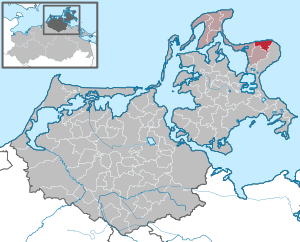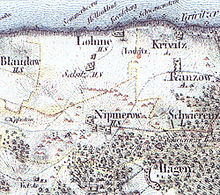Wages
| coat of arms | Germany map | |
|---|---|---|

|
Coordinates: 54 ° 35 ' N , 13 ° 37' E |
|
| Basic data | ||
| State : | Mecklenburg-Western Pomerania | |
| County : | Western Pomerania-Ruegen | |
| Office : | North Ruegen | |
| Height : | 15 m above sea level NHN | |
| Area : | 13.78 km 2 | |
| Residents: | 449 (Dec. 31, 2019) | |
| Population density : | 33 inhabitants per km 2 | |
| Postal code : | 18551 | |
| Area code : | 038302 | |
| License plate : | VR, GMN, NVP, RDG, RÜG | |
| Community key : | 13 0 73 052 | |
| Office administration address: | Ernst-Thälmann-Strasse 37 18551 Sagard |
|
| Website : | ||
| Mayor : | Mrs. Joyce Klöckner ( CDU ) | |
| Location of the municipality of Lohme in the district of Vorpommern-Rügen | ||
Lohme is a municipality in the district of Vorpommern-Rügen on the island of Rügen in Mecklenburg-Western Pomerania (Germany). It borders on the famous Rügen chalk cliffs with the stump chamber .
geography
location
The municipality is administered by the North Rügen Office with its seat in the municipality of Sagard . The old fishing village of Lohme, which gave the municipality its name, is located directly on the approximately 50 meter high cliff on the northern edge of the Jasmund peninsula , which here on the northeastern foothills of the Stubnitz mountain ranges up to 70 m above sea level. Has NN. A steep staircase leads down to the harbor, which was laid out in 1906 and modernized in 1997. After stabilization work on the steep slope, it is now accessible again. The Jasmund National Park borders on Lohme .
Local division
The following districts belong to the municipality of Lohme:
|
|
geology
The shape of the Jasmund steep bank near Lohme was formed at the end of the last Ice Age around 12,000 years ago, when the Jasmund ridges protruded from the ice of the North Ruger advance squadron, which last penetrated this area. The glacier stream which penetrated between today's peninsulas Wittow and Jasmund in southwestern direction, scraping at today cliff before Lohme along, but also outsourced boulder clay from which to rainy winter leads to the below-mentioned slope instability today. In the period from 8000 to 6000 years ago, the sea level in the Baltic Sea rose rapidly from below minus 20 m to today's level. Since then, the mostly strong surf has caused coastal erosion , which has led to the stone beach that is found today .
history
Neolithic to Middle Ages
The area was settled in the Neolithic around 5500 years ago ( funnel cup culture ). This is evidenced by large stone graves such as the Neolithic passage grave near Nipmerow on the Magelowberg ( ⊙ ), which was discovered in 1983 during excavations of a supposed Bronze Age barrow , and the Pfenniggrab (Pfennigkasten, ⊙ ), which was first mentioned in 1745. A Bronze Age settlement (1800–600 BC) is documented by a large number of barrows near Lohme and especially around Nipmerow. After that, there are traces of human use again from the time of Slavic settlement from 800 AD.
Lohme is derived from the Old Slavic word lomŭ for break, windbreak, quarry.
1300-1900
The place was part of the Principality of Rügen until 1325 , which had been under Danish feudal rule since 1168 , and then part of the Duchy of Pomerania . With the Peace of Westphalia of 1648, Rügen and thus also the area of Lohme became part of Swedish Pomerania . In 1815 Lohme came to the Prussian province of Pomerania as part of New Western Pomerania . From 1818 to September 4, 2011 Lohme belonged to the district of Rügen . Only from 1952 to 1955 it was part of the Bergen district. The community then belonged to the Rügen district in the Rostock district until 1990 and then became part of the newly formed state of Mecklenburg-Western Pomerania. Since 1884 Lohme has been one of the spa and bathing resorts that developed on the island of Rügen at that time. The expansion of the railway line to Bergen auf Rügen (1883) and on to Sassnitz (1891) had a particularly positive influence on this . A men's pool was built east of the Schwanenstein and a women's pool on the beach in the direction of Blandow. These were pile dwellings, boarded up over wooden stairs, which allowed bathing in the open sea without "bothering" strangers. Bathing on a wide sandy beach was not yet in fashion and the proximity to the forests of the Stubnitz and the unobstructed view of Cape Arkona opposite made Lohme so attractive that z. B. 1924 the 154 inhabitants accommodated 1,600 spa guests.
After 1900
On the night of February 26th to 27th, 1900, the mail steamer Rex of the Königslinie stranded on the beach in front of Blandow near Lohme on the way from Trelleborg in Sweden to Sassnitz. Five women drowned when a boat attempted to bring them ashore. The ship broke in the surf three days later.
The Ranzow beacon near Lohmes was in operation from 1905 to 1999 . It flashed every five seconds from a height of 55 m up to 14 nautical miles. It was dismantled in 2002 and erected in 2004 as a technical monument at Cape Arkona.
A landmark of Lohme that could be seen from afar were the steel-lattice transmission masts of the former Rügen Radio coastal radio station . The operation of this radio transmitter began in 1932 and ended in 1998, only interrupted in the post-war years 1945 to 1949. The last transmitter mast was dismantled on April 4, 2018. Today there is a cell tower at the site .
In 1997 the port of Lohme was expanded to a marina with 53 berths. Since 1997, the town center has been thoroughly renovated as part of the urban development subsidy.
Humpback whale
On the evening of August 3, 2008, an approximately 12 m long humpback whale was observed in front of the port of Lohme , which had lost its way into the Baltic Sea. First sighted at Cape Arkona on July 25th, he had swum on to the Polish Baltic Sea coast, and then on his way back past Lohme into the Tromper Wiek .
Cliff demolished in 2005
On March 19, 2005, in the immediate vicinity of the Lohmer harbor, the cliff broke off over a length of around 100 m and a width of 200 m, with around 100,000 m³ of earth slipping in the direction of the Baltic Sea on the clay and marl layers below . The Diakoniehaus von Lohme, a care home for addicts, which was located directly on the edge of the demolition, narrowly escaped the disaster: The edge of the break ran 2.5 m in front of the house, whereupon the home together with a number of other buildings at the edge of the demolition were initially blocked has been.
After this blockage could be lifted again except for two bungalows and the Diakoniehaus in May 2008, the latter was torn down in May – June 2008 with the help of remote-controlled hydraulic pliers, as the ground would no longer have supported construction vehicles in the immediate vicinity of the building. As a result, hydrogeological investigations were carried out in large parts of Lohme for the further stability of the steep coast, on the basis of which in June 2009 a further ban on the use of six buildings on the steep slope of Lohme was issued.
The main problem of slope stability turned out to be the groundwater , which is present in large quantities in spring and is prevented from seeping away by water-retaining layers of soil , on which the overlying layers of earth threaten to slide towards the Baltic Sea.
In order to prevent further demolition, a slope foot drainage was carried out from 2009 to 2010 with state funds, which diverts the groundwater from the water-bearing soil layers of the steep slope into the Baltic Sea by means of horizontal drainage. The construction work required for this required a high level of technical effort for the horizontal drainage. In order not to put any further strain on the steep slope, transport to and from the site was only carried out by sea.
With 15 horizontal drains from 32 to 56 meters in length, the groundwater level was lowered by 4.5 meters and the stability of a long section of steep slope increased considerably.
History of the districts
Ranzow was first mentioned in a document in 1314. The place or the estate was owned by the von Jasmund families (16th century), von der Osten , von der Lancken (from 1596), von Bötticher (19th century to after 1900), Philipp Isaacsohn, von Seydlitz (20th century) . Century). The romantic mansion with a high tower from around 1900 was created by converting an older building; It was used for military purposes from 1941 to 1991, and has been a hotel since 2001.
politics
City council and mayor
In the municipal council were elected
- CDU: 2nd
- FWG: 3
- The left: 1
Mayor is Mrs. Joyce Klöckner (CDU).
coat of arms
The coat of arms was approved by the Ministry of the Interior on July 9, 2001 and registered under the number 247 of the coat of arms of Mecklenburg-Western Pomerania. The coat of arms was designed by Gerhard Koggelmann from Sagard .
Blazon : "In blue on a silver stone flattened towards the rear, a gold-armed silver swan ready to fly."
Attractions
→ See also the list of architectural monuments in Lohme
- Lohme harbor with a demolished slope
- Ranzow Castle and golf course
- Great stone grave Nipmerow
- Schwanenstein and Erratic Beach in Lohme
- Boulder Nardevitz
- Blandow boulder
Economy and tourism
The economy of Lohmes is primarily shaped by tourism, with the surrounding landscape being the attraction of the municipality. Lohme is the starting point for many hiking trails through the national park or along the high riverside path towards Glowe . Countless different plants bloom there in spring. Cape Arkona can also be seen from Lohme .
In the district of Hagen there is the large car park, which is used daily by thousands of visitors to the Jasmund National Park, who then walk the remaining three kilometers to the National Park Center at Königsstuhl or use the shuttle bus to get there.
Web links
- Municipality of Lohme ( Memento from January 1, 2014 in the Internet Archive )
- Literature about Lohme in the state bibliography MV
Individual evidence
- ↑ Statistisches Amt MV - population status of the districts, offices and municipalities 2019 (XLS file) (official population figures in the update of the 2011 census) ( help ).
- ^ Paul Kühnel: The Slavic place names in Meklenburg. In: Yearbooks of the Association for Mecklenburg History and Archeology. Vol. 46, 1881, ISSN 0259-7772 , pp. 3-168, here p. 86.
- ↑ Fight with the coast: demolition of the Diakonie-Heim in Lohme begins - Schweriner Volkszeitung
- ↑ Securing the steep slope Lohme - Slope foot drainage ; Information board of the Wastraplan engineering company Rostock at the port of Lohme, March 2011.








